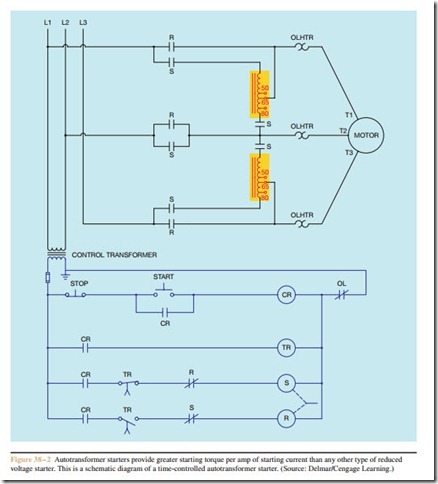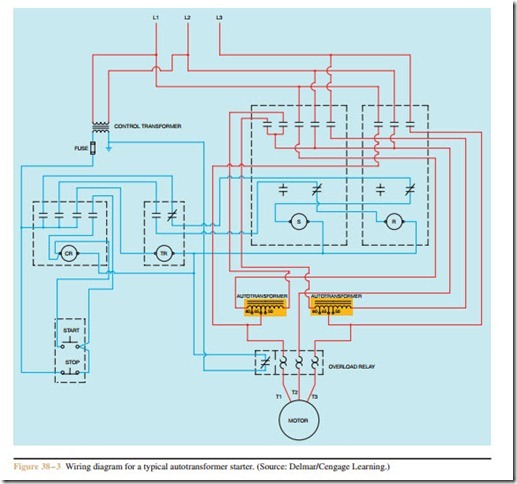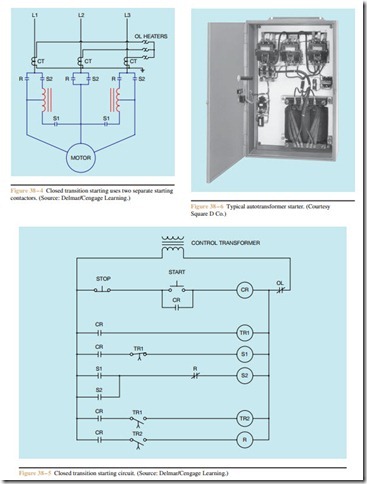Open and Closed Transition Starting
Open transition starting is generally used on starters of size 5 and smaller. Open transition simply means that there is a brief period of time when the motor is dis- connected from power when the start contactor opens and the run contactor closes. The circuit shown in Figures 38 – 2 and 38 – 3 are examples of an open transition starter.
Closed transition starting is generally used on starters size 6 and larger. For closed transition starting, two separate start contactors are used (Figure 38 – 4). When the motor is started, both S1 and S2 contactors close their contacts. The S1 contacts open first and separately from the S2 contacts. At this point, part of the autotransformer windings are connected in series with the motor and act as series inductors. This permits the motor to accelerate to a greater speed before the R contacts close and the S2 contacts open. Although the R and S2 contacts are closed at the same time, the inter- val of time between the R contacts closing and the S2 contacts opening is so short that it does not damage the autotransformer winding.
Notice that the circuit in Figure 38 – 4 contains three current transformers (CTs). This is typical in circuits that control large horsepower motors. The CTs re- duce the current to a level that common overload heaters can be used to protect the motor. A schematic
diagram of a timed circuit for closed transition starting is shown in Figure 38 – 5. When the motor reaches the run stage, it is connected directly to the power line and the autotransformer is completely disconnected from the circuit. This is done to conserve energy and extend the life of the transformers. A typical autotransformer starter is shown in Figure 38 – 6.
Review Questions
1. Why is it desirable to disconnect the autotrans- former from the circuit when the motor reaches the run stage?
2. Explain the differences between open and closed transition starting.
3. Autotransformers often contain taps that permit different percentages of line voltages to be con- nected to the motor during starting. What are three common percentages?
4. Refer to the circuit shown in Figure 38 – 2. Assume that timer TR1 is set for a time delay of 10 sec- onds. When the Start button is pressed, the motor does not start. After a period of 10 seconds, the motor starts with full line voltage applied to it. Which of the following could cause this condition?
a. Timer TR coil is open.
b. CR coil is open.
c. Contactor S coil is open.
d. Contactor R coil is open.
5. Refer to the circuit shown in Figure 38 – 2.
Assume that timer TR is set for a delay of 10 seconds. Assume that contactor coil R is open. Explain the operation of the circuit if the Start button is pressed.
6. Refer to the circuit shown in Figure 38 – 5. Assume that timer TR1 is set for a delay of 10 seconds and timer TR2 is set for a delay of 5 seconds. After the Start button is pressed, how long is the time delay before the S1 contacts open?
7. Refer to the circuit shown in Figure 38 – 5.
Assume that timer TR1 is set for a delay of 10 seconds and timer TR2 is set for a delay of 5 seconds. From the time the Start button is pressed, how long will it take the motor to be connected to full line voltage?
8. Refer to the circuit shown in Figure 38 – 5. Ex- plain the steps necessary for coil S2 to energize.
9. Refer to the circuit shown in Figure 38 – 5. What causes contactor coil S2 to de-energize after the motor reaches the full run stage?
10. Refer to the circuit shown in Figure 38 – 5. Assume that timer TR1 is set for a delay of 10 seconds and timer TR2 is set for a delay of 5 seconds. When the Start button is pressed, the motor starts. After 10 seconds, the S1 contacts open and the motor continues to accelerate but never reaches full speed. After a delay of about 30 seconds, the motor trips out on overload. Which of the following could cause this problem?
a. TR1 coil is open.
b. S2 coil is open.
c. S1 coil is open.
d. R coil is open.


